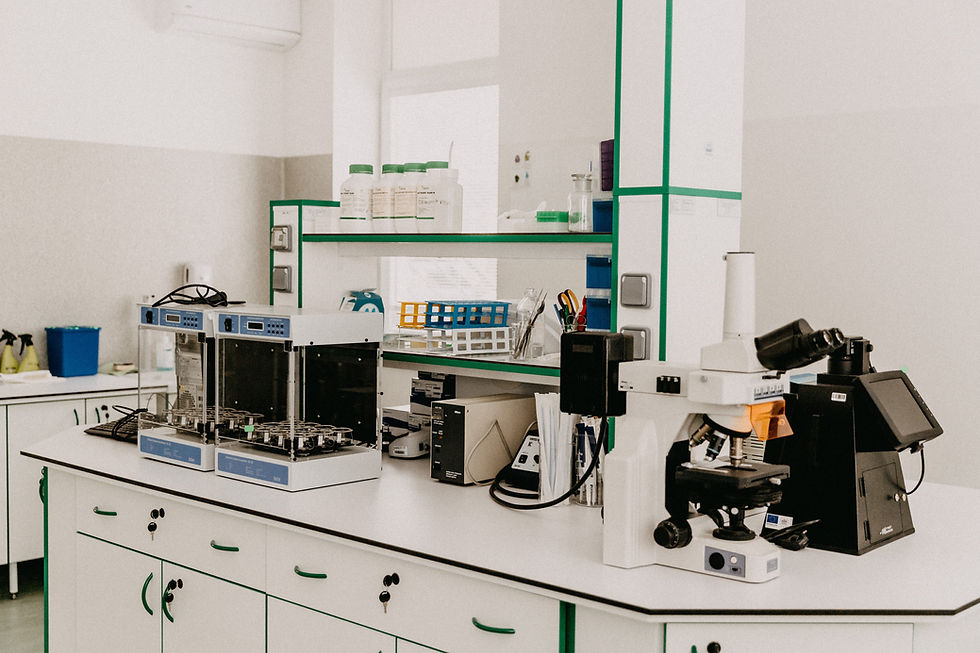Laboratories & Research Facilities
- Alex Graft
- Oct 24, 2022
- 4 min read
What is a Laboratory?
A laboratory is a facility that provides controlled conditions in which scientific or technological research, experiments, and measurements may be conducted. Laboratory services collaborate in a range of different occupations such as clinics, hospitals and referral centres.

What Are The Risks?
From flammable materials, trip hazards, and even biohazards – the laboratory can be a dangerous place.

So, there are numerous aspects of risk minimization that must be examined in order to establish a workplace which is both safe, and compliant with health and safety legislation.
A hazard which is common to a multitude of laboratory types, from the life sciences, physics research to chemistry departments, is posed by gases.
Research Applications - Think Oxygen!
Research applications can have a range of gases which require continuous monitoring such as natural gas, oxygen and carbon dioxide.
Asphyxiant gases are very common in laboratories; these are gases which are non-or minimally toxic but can dilute the oxygen in air, leading to unconsciousness or death if breathed long enough.

Asphyxiant gases are relatively inert, their presence in large quantities may not be noticed until the effects of elevated carbon dioxide in blood are recognised by the body. Examples of asphyxiant gases are nitrogen, argon and helium. Asphyxiation can also occur due to high volumes of other toxic gases as well as Methane.
Research Applications - Think Explosive!
Another category of risk posed by gases used in laboratories is the explosion/flammability risk. Gases are typically stored in pressurised cylinders, and improper handling can lead to cylinder damage with sudden pressure discharge and explosions. Any small spark from electrical equipment or hot surfaces can be sufficient to trigger a fire. Furthermore certain gases also pose a toxic hazard for example, carbon monoxide and nitrous oxide.

Equipment and personnel must therefore be protected against combustible, toxic/flammable gases and asphyxiation at all times. Any laboratory using inert gases such as argon, nitrogen or helium as carrier gases or in cryogenics we would recommend a Fixed Gas Detection system for the laboratory and a Portable Gas Monitor for the individual to wear as an added level of detection.
Pharmaceutical and Biotechnology Labatories
Industrial gases are essential to the development of modern medicines and the production of pharmaceutical packaging.

Pharmaceutical and biotechnological companies use gases in a wide range of applications across all stages of the production chain – from research, development and quality control to production of active pharmaceutical ingredients and final drugs. Industrial gases are essential to the development of modern medicines and the production of pharmaceutical packaging.
Early Leak Detection
The development of new pharmaceutical drugs relies heavily on modern laboratory equipment in which speciality gases are essential. Speciality gases are gases which are rare or more usually gases of an extremely high purity (over 99.9%).

– Nitrogen & The Noble Gases – Carbon Dioxide; Carbon Dioxide (CO2) – Oxygen; Enriched Oxygen (O2)
Leak checks to analytical laboratory equipment promotes good laboratory practice and preventative maintenance offering a number of benefits including; improvements to analytical performance, minimising troubleshooting, and the prevention of damage to columns and sensitive detectors.
Gas leaks can cause significant losses of expensive high-quality gas, shortened trap and purifier lifetimes, increased column bleed, and increased system and detector maintenance. Many problems can be minimised by installing a Fixed Gas Detection system.

In addition to increase ability for early leak detection you could install a leak detection system such as SearchZone Sonic by Honeywell or Observer-I by MSA. These detectors are fitted strategically to monitor the pipe to detect any leaks, this is an extra pre-cautionary measure that means that if any leaks happen you will be alerted before the gas detection sensors detect it.
This leak detector works by using audio to hear the physical leak. This saves valuable time when it comes to unwanted exposure as leaks can be identified quickly, this saves the Laboratory having to close for longer periods of time if a leak occurred and as a consequence saves money.
Most importantly this is an additional level of indication that individuals would benefit from who are operating the laboratories on a regular basis.
"I think I may need Safety Instrumentation Monitoring, but I don’t know anything about it!"
You don’t need to understand Safety Instrumentation Monitoring to be safe at work! If you are unsure whether you need a monitor, please call one of the team on the below number.

Call The Team: 01489 326031
You cannot create the need for Safety Instrumentation, the need is either there or isn’t – that why the best way to make sure you are keeping yourself and your own team as safe as possible is to give one of our experienced team members a call! You can speak to us about your site and our team will be able to advise you based off extensive working knowledge, existing and pre-existing clients/projects and industry specific hazards. Our team remain informed in the world of Safety Instrumentation so that we can provide up to date advice in line with best practices. This means whenever you speak to our team you know you are receiving updated support from people who care.
"Our work should enrich our lives, not cost them" - Alex Graft (Managing Director)





Comments